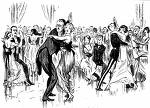
[This is taken from the Ballroom Guide]
Throughout the Ball-room Guide we have endeavoured to avoid as much as possible
the rise of French words, and to give our directions in the plain mother tongue.
Nevertheless there must always be certain technical terms, such as chassez
croisez, glissade, &c., &c., for which it would be difficult to find good
English equivalents. We therefore subjoin a Glossary of all such words and
expressions as have long since been universally accepted as the accredited
phraseology of the Ballroom.
A vos places, back to your own places.
A la fin, at the end.
A droite, to the right.
A gauche, to the left.
Balancez, set to your partners.
Balancez aux coins, set to the corners.
Balancez quatre en ligne, four dancers set in a line, joining hands, as in La Poule.
Balancez en moulinet, gentlemen and their partners give each other right hands across, and balancez in the form of a cross.
Balancez et tour des mains, all set to partners, and turn to places.
(See Tour des mains.)
Ballotez, do the same step four times without changing your place.
Chaine Anglaise, opposite couples right and left.
Chaine des dames, ladies’ chain.
Chaine Anglaise double, double right and left.
Chaine des dames double, all the ladies perform the ladies’ chain at the same time.
Chassez croisez, do the chasse step from left to right, or right to left, the lady passing before the gentleman in the opposite direction, that is, moving right if he moves left, and vice versa.
Chassez croisez et dechassez, change places with partners, ladies passing in front, first to the right, then to the left, back to places. It may be either a quatre four couples—or les huit--eight couples.
Chassez a droite—a gauche, move to the right—to the left.
Le cavalier seul, gentleman advances alone.
Les cavaliers seuls deux fois, gentlemen advance and retire twice without their partners.
Changez vos dames, change partners.
Contre partie pour les autres, the other dancers do the same figure.
Demi promenade, half promenade.
Demi chaine Anglaise, half right and left.
Demi moulinet, ladies all advance to centre, right hands across, and back to places.
Demi tour a quatre, four hands half round.
Dos-a-dos, lady and opposite gentleman advance, pass round each other back to back, and return to places.
Les dames en moulinet, ladies give right hands across to each other, half round, and back again with left hands.
Les dames donnent la main droite—gauche—a leurs cavaliers, ladies give the right—left—hands to partners.
En avant deux et en arriere; first lady and vis-a-vis gentleman advance and retire. To secure brevity, en avant is always understood to imply en arriere when the latter is not expressed.
En avant deux fois, advance and retreat twice.
En avant quatre, first couple and their vis-a-vis advance and retire.
En avant trois, three advance and retire, as in La Pastorale.
Figurez devant, dance before.
Figurez a droite—a gauche, dance to the right—to the left.
La grande tour de rond, all join hands and dance, completely round the figure in a circle back to places.
Le grand rond, all join hands, and advance and retreat twice, as in La Finale.
Le grand quatre, all eight couples form into squares.
La grande chaine, all the couples move quite round the figure, giving alternately the right and left hand to each in succession, beginning with the right, until all have regained their places, as in last figure of the Lancers.
La grande promenade, all eight (or more) couples promenade all round the figure back to places.
La main, the hand.
La meme pour les cavaliers, gentlemen do the same.
Le moulinet, hands across. The figure will explain whether it is the gentlemen, or the ladies, or both, who are to perform it.
Pas d’Allemande, the gentleman turns his partner under each arm in succession.
Pas de Basque, a kind of sliding step forward, performed with both feet alternately in quick succession. Used in the Redowa and other dances. Comes from the South of France.
Glissade, a sliding step.
Le Tiroir, first couple cross with hands joined to opposite couple’s place, opposite couple crossing separately outside them; then cross back to places, same figure reversed.
Tour des mains, give both hands to partner, and turn her round without quitting your places.
Tour sur place, the same.
Tournez vos dames, the same.
Tour aux coins, turn at the corners, as in the Caledonians, each gentleman turning the lady who stands nearest his left hand, and immediately returning to his own place.
Traversez, cross over to opposite place
Retraversez, cross back again.
Traversez deux, en dormant la main droite, lady and vis-a-vis gentleman cross, giving right hand, as in La Poule.
Vis-a-vis, opposite.
Figure en tournant, circular figure.
Copyright © D. J. McAdam· All Rights Reserved